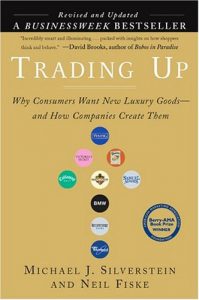I have read many books in the last two years, ranging from business to auto-biographies to self-help to fiction books. I just put down a book titled “Trading Up” (find it on Flipkart or Amazon) after reading it for two weeks. And what a captivating read it was! It was difficult to put it down once I started it. One reason could be that the book was about retail and shopping, and I am already interested in that because of my experience with SaleRaja and exposure to the retail world. But apart from that too, the book was very well researched and a lot of data has been presented in the book to justify the points made.
The book has tried to illustrate how middle class consumers are ‘trading up‘ to buy high quality products that deliver benefits on many different levels, even at a price premium and how that is breaking the traditional price-volume demand curve. The product could be as simple as a soap and as complex as cars. The basic premise is that traditionally, the markets have had two kind of products, the conventional goods that sell at low margins and high volumes and the luxury goods which sell at high margins and low volumes. The author has remarked in the book that in many industries, there is a huge gap between these two segments.
He has called the products falling in these two categories as ‘new luxury‘ products that are technically superior and also have an emotional advantage for the consumer. He has given many examples of such companies such as Starbucks (coffee), Callaway Golf (golf equipment), American Girl (dolls), Panera Bread (bread), Belvedere (vodka), Whirlpool Duet (washing machine) and others. One distinct characteristic of these products is that they sell at high margins and high volumes, much above the traditional price-volume demand curve.
He has presented these stories as case studies of how different companies saw the huge gap in the market and came with their innovative products that created a new ‘want‘ and market for these consumers who traded up. He has backed his theories with data to substantiate them. He has also looked at some characteristics of the entrepreneurs and tried to find a common ground between them and their approaches as they created products for the new consumer.
The authors have defined some characteristics of the new consumers as below –
- The new middle market consumer is smart and has more disposable money than ever.
- The new consumer won’t mind buying products at a premium if the product is superior in quality and gives them a feeling of comfort and satisfaction.
- The new consumer choose which brands and products they want to be associated with, ones that define their status and personality.
- They are ready to buy these products at a higher price, and will trade down in other unimportant products.
Some characteristics of the companies and entrepreneurs that build these products are –
- They are mostly outsiders to the market, and even if not, attack the market like an outsider. They strive to set new standards for innovation, quality and providing an emotional experience for the consumer.
- They understand their target markets, and are aware that they will pay a premium if provided a product that can engage with its customers on an emotional level.
- They love what they do, and are consumers of their own products.
- They customize their value chains and distribution networks to deliver their products in the best possible way, and use influence marketing with celebrities rather than traditional advertising. They focus more on word of mouth marketing.
Perhaps the most important point the authors have made is people perceive value differently than previously thought. They will pay a premium and buy such a product in higher volumes even during a down economy. If the product is superior and gives much more satisfaction than the currently available products, the consumer will perceive its value differently and trade up in this category, even if it means they have to trade down in other unimportant categories.
This book, which you can buy on Flipkart or Amazon, helps a lot to understand the current changes happening not only in developed countries, but also in emerging economies like India. It not only gives examples of such companies and entrepreneurs but also explains HOW they did it? It is a must read for anybody in business or someone who plans to launch a new business soon. This sets the book apart from other business books and keeps the user hooked throughout the book. It also made me understand why my friends and peer group spend the way they do, and how can an entrepreneur (future me) develop products and services to target this ever expanding segment. In summation, I totally loved it!!

